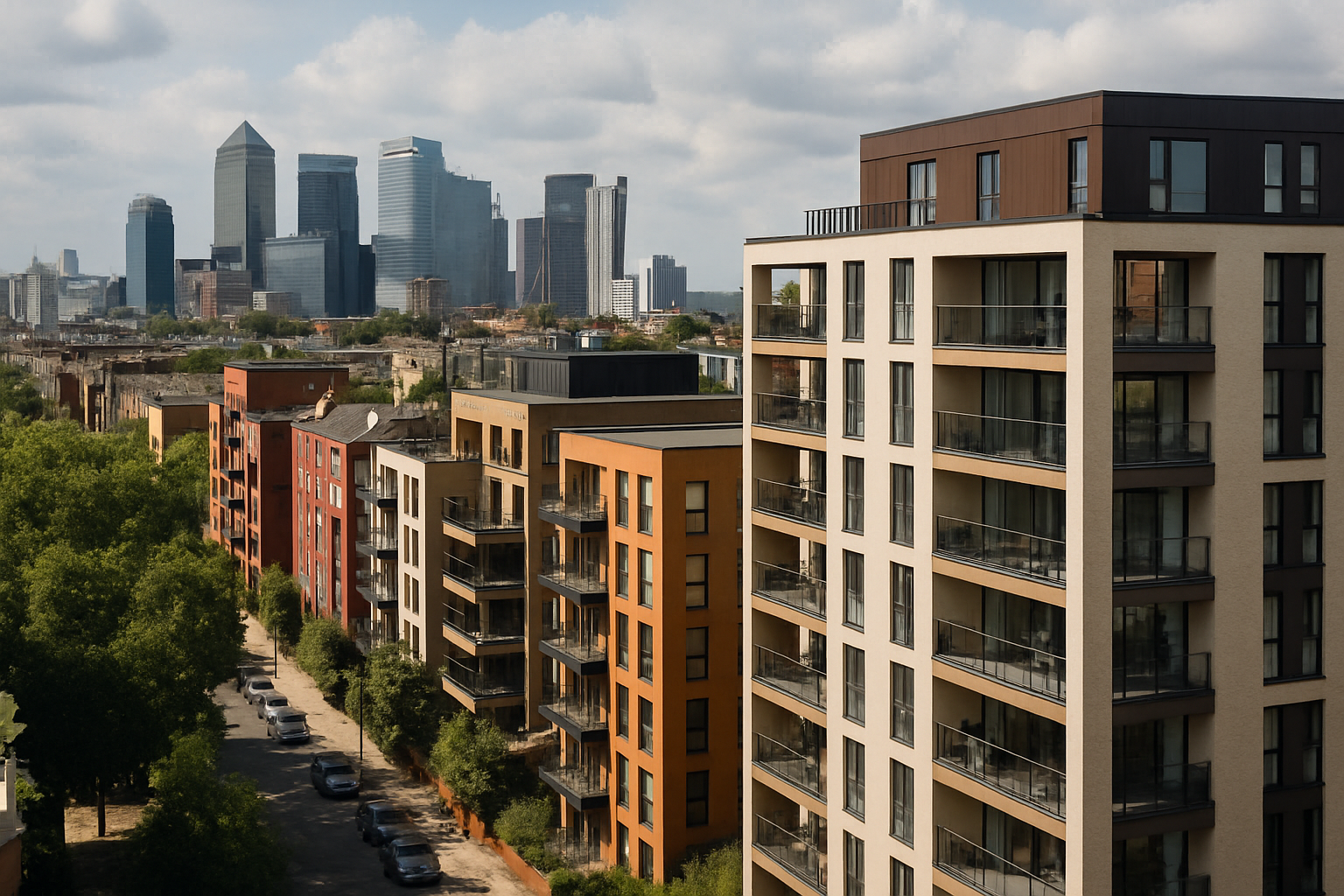Buying new build property in London has always been a high-stakes decision, especially for international buyers trying to navigate complex planning systems, shifting regulations, and unpredictable timelines. But what makes 2025 different is this: supply is tightening just as pricing pressure is easing.
Construction inflation is cooling. Developers are adjusting strategies. And regulatory bottlenecks are creating scarcity in viable, near-completion projects. If you know where to look and what to avoid, this window could offer rare access to below-peak pricing, stronger rental yields, and long-term growth.
But knowing where and what to buy isn’t simple. That’s where we come in.
At Entralon, we don’t just list properties; we help you interpret the market, compare options with AI-backed insight, and match you with only those homes or investments that align with your needs, timeline, and budget.
Tell us what you’re trying to achieve, and we’ll show you which opportunities are worth your time.
Contact Entralon
Why New Build Prices Are Stabilising in 2025
After years of sharp cost increases, the London property market is showing early signs of price stabilisation, especially across new build homes in London. According to the latest data, construction inflation has slowed to 2.3% year-on-year in Q1 2025, a marked decrease from the 5.5% peak recorded in 2023. This cooling trend reflects improved material availability and easing supply chain constraints.
For overseas buyers and investors looking to buy property in London, this creates a rare moment of price predictability. Developers, facing tighter regulations and cautious lending environments, are rebalancing pricing strategies to keep their off-plan property in London attractive and financially viable. This has opened the door to more flexible terms for early-stage buyers.
For instance, select developers in Zones 2 and 3 are now offering extended payment plans, reduced deposits, or stamp duty contributions, initiatives that were rare just two years ago. These incentives are helping overseas investors seize strong positions in projects that might otherwise remain out of reach.
However, this pricing pause won’t last forever. With a government-backed push for 1.5 million new homes by 2030, London property investment is set to become more competitive again. Early movers who understand these market dynamics can benefit from today’s softer pricing and stronger long-term value.
What Is Delaying New Supply and Why Does That Matter
Behind the growing interest in off-plan property in London lies a critical issue: supply is struggling to keep pace with demand. While construction costs are stabilising, the delivery of new build homes in London is being held back by complex planning and regulatory barriers.
One of the main culprits is the Building Safety Act, particularly the Gateway 2 approval process, which applies to residential buildings over 18 metres. Approvals are now taking over 40 weeks in some cases, more than twice as long as the pre-2021 average of 16 to 20 weeks. These extended timelines are forcing developers to delay projects significantly and re-evaluate viability.
At the same time, updates to British Standard BS9991, including mandatory evacuation lifts, have added new layers of design and cost complexity to high-rise projects. For developers, this means longer design phases and higher upfront investment; for buyers, it translates into tighter project pipelines.
Quick Glance: What BS9991 Means for Developers
- Mandatory evacuation lifts in high-rise buildings
- Dual staircases in some schemes
- Added structural and mechanical costs
- Extended design phases and compliance reviews
For those looking to buy property in London, this regulatory bottleneck results in reduced supply and stronger long-term value for completed or nearly completed projects. Developers are now facing delays of up to 12 months on average, making the existing pipeline more valuable and pushing early-buyer incentives to more competitive levels.
For example, some developers are currently offering up to 5% discounts on near-complete units, or covering part of legal and mortgage costs to attract serious buyers, offers rarely seen in the pre-2023 cycle.
As a result, London property investment is shifting focus: instead of chasing unstarted projects, savvy investors are prioritising those with clear planning approvals or near-term delivery, especially in areas benefiting from urban regeneration.
Discover the most promising new build homes in London, curated for investors who care about value, timing, and long-term potential.
Explore London property investment opportunities on Entralon
What Types of Developments Are Still Viable?
Despite regulatory headwinds and planning delays, not all property types face the same pressure. For overseas buyers seeking to buy property in London, certain segments of the market are proving more resilient and even strategically advantageous.
Co-living developments are gaining traction as a complementary alternative to traditional new build homes in London. With higher density, shared amenities, and greater value per square metre, co-living offers a smart route into high-demand areas without the typical premium price tag. Occupancy rates in established co-living schemes across Zones 2 and 3 have consistently exceeded 92% since mid-2023, reflecting strong tenant demand, particularly from young professionals, digital nomads, and remote workers seeking flexible, community-focused living.
Similarly, purpose-built student accommodation (PBSA) continues to outperform, especially in cities with persistent housing shortages. In London, student housing applications rose by 14% year-on-year in 2024, while the growth in PBSA supply lagged at just 4%. For investors focused on yield and long-term occupancy, PBSA remains a core opportunity in the London property investment landscape, backed by structural demand in key university zones.
Another viable route for buyers exploring off-plan property in London is the rise of large-scale refurbishments and permitted development (PD) conversions. These projects often bypass some of the planning constraints affecting ground-up construction, allowing for faster delivery and often more sustainable outcomes. For example, the conversion of vacant commercial spaces into residential units in Zones 2 and 3 is already reshaping local markets and presenting early-stage buyers with access to prime locations at better value.
Which One Might Be Right for You?
- Want long-term stable rental yield? → Look into PBSA.
- Buying early in vibrant, high-density areas? → Co-living could be ideal.
- Prefer fast turnaround or sustainability-focused projects? → Consider refurbished or permitted development units.
Final Thoughts
Why 2025 Is a Strategic Window for Buying Property in London?
The London property market in 2025 presents a unique convergence of factors favourable to buyers. While national house prices have risen by 3.9% over the past year, London has experienced a slight decline of 1.4%, offering a rare opportunity for negotiation and value acquisition.
Regulatory changes, such as the Building Safety Act’s Gateway 2 process and updates to British Standard BS9991, have introduced complexities that slow down new developments. This slowdown has led to a constrained supply of new build homes, particularly in high-demand areas. For buyers, this means that existing and nearly completed properties are becoming more valuable, and developers are more open to offering incentives to secure sales.
Moreover, alternative property types like co-living spaces and purpose-built student accommodations (PBSA) are showing resilience. Occupancy rates for co-living have remained above 92% since mid-2023, and student housing applications in London increased by 14% year-on-year in 2024, outpacing the 4% growth in PBSA supply.
Ready to Explore Your Options?
If you’re considering investing in London’s property market, now is a rare window of opportunity.
At Entralon, we offer one-on-one consultations, powered by smart analytics and AI, to help you find properties that truly align with your goals.
Visit our site to see what’s available now.
FAQ
1. Is 2025 a good time to buy property in London?
Yes, 2025 offers a favourable environment for buyers. London has seen a slight price decrease, and developers are more open to negotiations due to slowed new developments.
2. Can foreigners buy property in London?
Absolutely. There are no restrictions on foreign nationals purchasing property in the UK, including London. However, securing a mortgage may require a larger deposit, typically between 20-40%.
3. What additional costs should I consider when buying property in London?
Beyond the purchase price, buyers should account for stamp duty (with thresholds changing in 2025), legal fees, survey costs, and potential renovation expenses. First-time buyers now pay stamp duty on properties over £300,000.
4. What are the differences between freehold and leasehold properties?
Freehold means you own the property and the land it’s on indefinitely. Leasehold indicates you own the property for a set period but not the land, often requiring ground rent payments. Recent reforms are making leasehold ownership more transparent and fair.
5. How long does the property buying process take in London?
Typically, the process takes 8-12 weeks from offer acceptance to completion. However, factors like mortgage approval, surveys, and legal checks can influence the timeline.




























Discussion